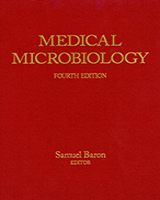NCBI Bookshelf. A service of the National Library of Medicine, National Institutes of Health.
Baron S, editor. Medical Microbiology. 4th edition. Galveston (TX): University of Texas Medical Branch at Galveston; 1996.
Microbes and Humanity
Microbes may be the most significant life form sharing this planet with humans because of their pervasive presence and their utilization of any available food source, including humans whose defenses may be breached. Microbial diseases are frequent and often severe, e.g. AIDS, cholera, tuberculosis, rabies. The ubiquitous presence of microbes and their astronomic numbers give rise to the many mutants that account for rapid evolutionary adaptation and in part for emerging diseases such as AIDS, ebolla and antibiotic-resistant tuberculosis. This adaptability also accounts for the ability of microbes to utilize an enormous range of nutritional sources. Depending on the food source, microbes may have either beneficial roles in maintaining life or undesirable roles in causing human, animals and plant disease.
Beneficial roles of microbes include recycling of organic matter through microbe-induced decay and through digestion and nutrition in animals and humans. In addition, the natural microbial flora provides protection against more virulent microbes.
While microbes that cause infectious diseases are virulent, opportunistic diseases may also be caused by normally benign microbes. Opportunistic infections occur when the host defense mechanisms are impaired, microbes are present in large numbers, or when microbes reach vulnerable body sites. A striking example is HIV which impairs the host's defenses to multiple microbes. Because death or severe impairment of an infected host compromises the survival of the infecting microbe, natural selection favors a predominance of less virulent microorganisms, except when microbial transmission depends on disease manifestations (e.g., coughing and sneezing).
Understanding and employing the principles of microbiology and the molecular mechanisms of pathogenesis enable the physician and medical scientist to control an increasing number of infectious diseases. Our textbook brings together more than 100 internationally leading scientists to convey the mechanisms and principles of medical microbiology.
Rationale
Medical Microbiology is effectively two books in one: a comprehensive textbook of microbiology and a concise review text under General Concepts. Each chapter opens with a General Concepts section that distills the key information in the chapter and is designed to be used as a rapid review or study guide. The chapters themselves are comprehensive yet free of unnecessary detail. Another form of overview is provided by the illustrations, which are uniform, telegraphic, and self-explanatory. The natural history of major infectious diseases, for example, is summarized in an "everyperson" figure with a consistent format.
The book is written at a level appropriate for both medical students, physicians and infectious disease scientists. Medical relevance is emphasized throughout. Sections describe the clinical manifestations, diagnosis, and treatment of each infection, and the book concludes with a series of chapters that summarizes the infectious diseases in the context of the functioning organ systems.
Organization
Medical Microbiology begins with a review of the immune system, focusing on the body's response to invading microorganisms. Bacteria are then covered, first with a series of chapters presenting the general concepts of bacterial microbiology and then with chapters detailing the major bacterial pathogenes of humans. Similar sections cover virology, mycology, and parasitology. In each section, the introductory chapters stress the mechanisms of infection characteristic of that type of microorganism, thus providing the reader with a framework for understanding rather than memorizing the clinical behavior of the pathogens. The final section of the book Introduction to Infectious Diseases, is arranged by organ system and provides transition for clinical considerations.
Acknowledgements
Primary acknowledgement must go to the many dedicated scientists who have discovered the principles of microbiology. The scientific literature acknowledges individual contributions, but textbooks cannot adequately pay such tribute. Albert Einstein identified this problem, commenting that although "there are plenty of well-endowed (scientists)...it strikes me as unfair to select a few of them for recognition." We are indebted to all these unnamed investigators.
On a more immediate level, the editors are grateful to all our contributing authors for their enthusiasm and cooperation and to our consulting editors for their expert and exhaustive scientific review. Input from focus groups of medical students was invaluable in developing the educational approach of this textbook. The support of the University of Texas in encouraging faculty members to participate in this effort has been outstanding. Finally, the co-editors deserve particular praise. They have processed a formidable number of chapter manuscripts with dedication, attention to detail, scientific knowledge, and editorial skill. We also thank Dr. Premkumar Christadoss for his editorial review.
In addition, we thank Phyllis G. Baron for providing educational guidance. Our co-workers, especially Joyce Poast, Louese McKerlie, Kathleen Sabala and Linda Roberts, deserve grateful recognition for their indispensable help.
We acknowledge the previous chapters written by Dr. Mary Ann Gerencser, Dr. Carl F.T. Mattern, and Dr. Harry M. Meyer, Jr., who could not participate in this edition due to emeritus status or health.
The Staphylococcus and Treponema chapters are dedicated to the memory of Dr. Jay O'Cohen and Dr. Thomas J. Fitzgerald.
Samuel Baron, MD
- Preface - Medical MicrobiologyPreface - Medical Microbiology
- Homologene neighbors for GEO Profiles (Select 131961816) (0)GEO Profiles
- Multiple myeloma cell lines with acquired resistance to chemotherapeutic agent c...Multiple myeloma cell lines with acquired resistance to chemotherapeutic agent carfilzomibAccession: GDS5826GEO DataSets
- Related DataSets for GEO Profiles (Select 131931006) (1)GEO DataSets
- TMPPE transmembrane protein with metallophosphoesterase domain [Homo sapiens]TMPPE transmembrane protein with metallophosphoesterase domain [Homo sapiens]Gene ID:643853Gene
Your browsing activity is empty.
Activity recording is turned off.
See more...
